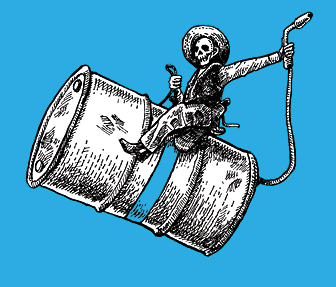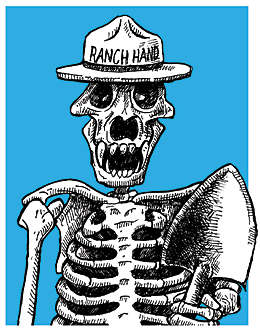 |
||||||||||||
|
May/June 2015
BY LOANA HOYLMAN
Agent Blue. Agent Orange. Agents Pink, Green, White, and Purple. The Rainbow Agents. Usually, they are all listed under “Agent Orange.” Each agent causes varying degrees of harm to living creatures, from plants to birds to humans. Agent Orange and most of the Rainbow Agents were phenoxy herbicides contaminated with dioxin. Agent Blue was the exception. Agent Blue was made of cacodylic acid and sodium cacodylate: arsenic compounds. Arsenic, the favored poison of the Middle Ages and the Renaissance, Agatha Christie and the Borgias. Everyone has heard of the lethality of arsenic, but despite the warnings of scientists and politicians, the U.S. military sprayed arsenic on rice paddies, bamboo groves, the Viet Cong, Vietnamese civilians, and its own personnel. Arsenic also is a carcinogen. There are two forms of arsenic. Organic arsenic is found in soil, water, and food around the world, and is not harmful except at high doses. Inorganic arsenic also can be found in nature, but not in things we ingest. It’s found with copper and lead and in soils near these metals. It’s also found in water, especially near ore deposits. Although organic arsenic is only dangerous in very high concentrations or for very long exposures, inorganic arsenic is highly poisonous. Under some circumstances, however, organic arsenic can transform into inorganic arsenic and wreak havoc. Many had argued that organic arsenic could never become inorganic, but that has been proven wrong. Until 2012, chickens in the U.S. were given compounds of arsenic to prevent certain diseases and to make the meat plump and pink. The chemical and chicken industries had insisted the arsenic was organic and, therefore, not poisonous. However, when livers of arsenic-treated chickens were compared to those not treated with arsenic, inorganic arsenic was found only in the former. Researchers concluded that organic arsenic had converted into the lethal inorganic arsenic. After the release of a 2011 peer-evaluated FDA study, 89 forms of 102 arsenic compounds were removed from the market because of the likelihood they could convert from organic to inorganic arsenic. There are many compounds of arsenic, many different names and labels. The bottom line is that arsenic is a heavy metal, like lead, and all heavy metals are dangerous and carcinogenic. Trail Dust. Ranch Hand. Pink Rose. They sound like sweet old cowboy songs, but they were operations for spraying herbicides in Vietnam. The U.S. Air Force conducted Operation Trail Dust. In Operation Ranch Hand, C-123 cargo transport planes were used to spray herbicides. The Air Force had the responsibility for 95 percent of the program. But all branches of the military were involved, as were South Vietnamese forces.
While all of the Rainbow Agents were used in defoliation, only Agent Blue targeted food crops. While the other agents destroyed broad-leaf vegetation, Agent Blue was used on narrow-leaved plants. It was used to destroy bamboo cover, but its main purpose was to kill rice and other grains. The rice paddies couldn’t be burned, and the phenoxy herbicides only worked on broad-leafed plants. Agent Blue desiccated the rice plants: They wilted and crumbled. Agent Blue was first used in 1962. Spraying continued until 1971. Vietnamese rice today remains tainted with arsenic. By attacking the food supply, reasoning went, villagers would be forced out and the villages would no longer provide support and protection for the Viet Cong. If small villages no longer existed, the enemy would be deprived of many bases. Agent Blue, then, contributed to the flood of peasants into urban areas. An estimated 1.5 million uprooted people lived in the slums of Saigon, many the victims of a policy of herbicide use. The villagers and the American and Vietnamese military personnel weren’t told of the dangers of herbicides. As a matter of fact, they were told the sprays were safe. In “Defoliation PSYOP of Vietnam,” Herb Friedman wrote that C-47 planes went either just before or just after the spray planes to drop leaflets explaining to the villagers that the herbicides were not dangerous and would keep everyone safe from the Viet Cong. Sometimes, small planes would fly over villages with tape-recorded messages to reassure villagers they weren’t in danger. But as Fred Wilcox wrote in Scorched Earth: Legacies of Chemical Warfare in Vietnam: “Making their way through Vietnam’s dense jungles, U.S. soldiers heard a cacophony of squawking birds, chattering monkeys, and insects buzzing like high-voltage wires. But after C-123 cargo planes swooped low over the trees, saturating them with Agent Orange, the ground was littered with decaying jungle birds, paralyzed and dying monkeys. Clusters of dead fish shimmered like buttons on the surface of slow-moving streams.” Many military personnel used hand sprayers. Agent Blue, in particular, was often sprayed by hand to kill bamboo. And spraying was done from the backs of trucks. Helicopters and river boats also sprayed herbicide agents. No one—not the hand sprayers, the pilots, the villagers, or the men on Navy boats—wore protective gear: no goggles, no face masks, no gloves, no suits. Men were soaked in it. But everyone was told it was harmless. Men made barbeque pits of the old barrels. People used them to hold drinking water and they were improvised for showers. The barrels were washed out by hand with no protection. Then that water was poured onto the soil or into the water. Arsenic can never be removed from the environment. The Air Force divided the Ranch Hands into three groups by level of potential danger. Pilots, copilots, and navigators were considered to be at low risk for contamination. Their exposure was through preflight checks and the missions themselves. Those risking moderate exposure were the crew chiefs, the mechanics, and those who drummed and loaded the chemicals, as well as those who repaired the equipment. The high-risk group included the spray operators and flight engineers who operated the equipment. Of course, now we know that the classifications were meaningless: Everyone was at high risk.
Did no one protest the use of such volatile chemicals? According to Lindsey Arison III in his report, “The Herbicidal Warfare Program in Vietnam, 1961-1971,” the RAND Corporation in 1967 argued against the use of the agents, especially Agent Blue. Spraying rice paddies to starve the enemy would be nearly useless, they reasoned, because there was enough rice in Vietnam to feed everyone, even after destroying hundreds of paddies with arsenic. But Agent Blue would harm the villagers and force many into urban slums. Maj. William A. Buckingham published a report, “Operation Ranch Hand: Herbicides in Southeast Asia,” in which he wrote that Alain C. Enthoven, the assistant secretary of defense for systems analysis, reviewed the RAND study and concluded that “the existing wholesale crop destruction program was counterproductive because it alienated the affected population without denying food to the Viet Cong.” Early on in the war, scientists and scientific organizations warned against the herbicide program. The Federation of American Scientists and the American Association for the Advancement of Science, as well as seventeen Nobel winners and five thousand scientists, petitioned to stop the use of chemical and biological weapons. By 1970, the Department of Defense suspended the use of Agent Orange, but used Agent White instead, which has the same properties as Orange. Agent Blue continued to be used for an additional year. The use of herbicides was begun at the insistence of South Vietnam President Ngo Dinh Diem. He pushed for it until President Kennedy gave the okay for testing Agent Blue against crops in Vietnam. Estimates of Agent Blue use vary widely. One estimate claims 19.6 million gallons were used, destroying 500,000 acres. According to the Institute of Medicine, 2,166,656 gallons of Agent Blue were sprayed on crops and cover between 1962 and 1971. The VVA Agent Orange and Dioxin Committee believes the quantity of herbicides is under-reported. Large as the numbers are, they understate the effects of Agent Blue. Spray drift, which can cover scores of miles, extended the poisonous reach. Another way it was spread was during Project Pink Rose. Crops and forests were sprayed, then they were burned. Burning intensifies the arsenic poison and makes it airborne, so people breathe it in. The ash spreads far and wide. Then there is where the agents were stored and where they were dumped, where the spray drifted, and where there were fires. There were also places in the U.S., Puerto Rico, Canada, and Thailand where arsenic compounds were tested. The first test spraying was done in 1961 just north of Dak To. Despite advice to the contrary, the whole operation was up and running by 1962. Agent Blue, like the other agents, was used at full strength. That is, it was not diluted, per recommendations of the chemical companies. Blue Water Navy Vietnam Vets reports that none of the agents sprayed in Vietnam were diluted, that they were used in a very concentrated form. The agents were used at up to fifty times the recommended concentration, according to a report by the Vietnam Friendship Village Project USA. Again, Fred Wilcox: “[We] drank water and ate food sprayed with Agent Orange. [We] slept on ground soaked with that shit. [We] got sprayed directly. Soaking wet. The government is lying. They can make up all the stories they want but we know better. They weren’t there. We were.” The men and women in Vietnam who were near the contaminated areas drank it, ate it, inhaled it, and wore it. Every study has concluded that arsenic is a carcinogen. The cancers always listed include bladder, stomach, and lung, and often, leukemia. Inorganic arsenic can cause increased chances of skin cancers, lymphatic cancers, and liver cancer. The Cancer Assessment Group of the EPA puts arsenic in the top category of cancer-causing chemicals: “It is no surprise that at even low concentrations, arsenic is responsible for lung, bladder, liver, and skin cancers.” Childhood cancers and birth defects have also been linked to arsenic. Chemicals such as arsenic are able to cross the placenta to create cancers in the fetus. The effects of arsenic often are not immediate. In fact, they can take decades to present. Arsenic can and does cause damage to DNA, which will last for generations. The New Jersey Department of Health/Hazardous Substance Fact Sheet lists sodium cacodylate high on its list because it is regarded by OSHA, DOT, DEP, IARC, and the EPA as a Special Health Hazard. The Agency for Toxic Substances & Disease Registry says of arsenic: “It cannot be destroyed once it has entered the environment, so that the amounts that we add can spread and cause health effects to humans and animals on many locations on earth. Arsenic can get into air, water, and the ground from wind-blown dust. It may also get into water from runoff.” And this: “Arsenic cannot be destroyed in the environment.” The U.S. National Library of Medicine, part of the National Institutes of Health, published in the Journal of Toxicology of 2011: “Arsenic from drinking water is a well-known risk factor for bladder cancer.” Vietnam veterans who were exposed to undiluted arsenic during the war are more vulnerable than the general population to arsenic exposure today, where it is widely used in pesticides, feed, and industrial uses—and also found naturally in water and food. Recently, interest in arsenic contamination has peaked because it has been found in water, rice, chicken, pork, turkey, grapes, apples, grape and apple juice, children’s snacks (especially rice-based snacks), low-end California wines, and wood preservatives. Although much of this arsenic is organic and natural, organic arsenic can transform into inorganic within vertebrate bodies. In an address to the Institute of Medicine concerning bladder cancer and arsenic, Bill Coberg said this: “There are a number of factors that increase the risk for bladder cancer among men including tobacco use; age; race; chemicals in certain occupations such as those used in textile, rubber, leather, dye, paint, or print industries; some naturally occurring chemicals; and chemicals called aromatic amines; chronic bladder problems such as bladder stones; certain chemotherapy and diabetes drugs; previous history of bladder cancer; and schistosomiasis. However, exposure to inorganic arsenic is also a risk factor and arsenic from drinking water is a well-known risk factor for bladder cancer.” So is being soaked in it. Bladder cancer is not on the Agent Orange Presumptive list for illnesses caused by service in Vietnam. Most of the Rainbow Agents were contaminated with dioxin, which is not particularly responsible for bladder cancer and some of the other illnesses caused by arsenic. Only Agent Blue contained arsenic, but all the agents were tossed together under the rubric “Agent Orange.” Most scientific studies associate bladder cancer, skin cancer, and lung cancer with arsenic contact. Bladder cancer is listed most often. The men and women in the military in Vietnam were in the midst of the heaviest arsenic program in the world.
|
||||||||||||
|
|
||||||||||||
|
||||||||||||
8719 Colesville Road, Suite 100, Silver Spring. MD 20910 | www.vva.org | contact us |
||||||||||||














